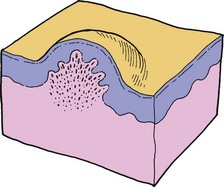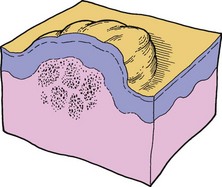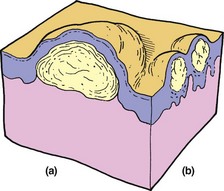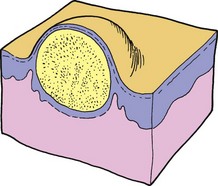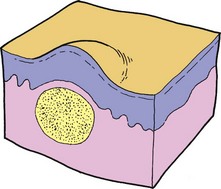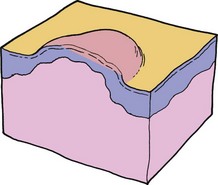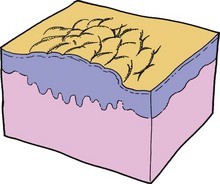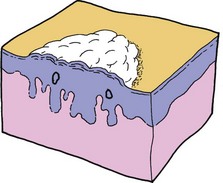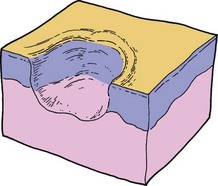Terminology of skin lesions
Dermatology has a vocabulary that is quite distinct from that of other medical specialties and without which it is impossible to describe skin disorders. A lesion is a general term for an area of disease, usually small. An eruption (or rash) is a more widespread skin involvement, normally composed of several lesions, which may be the primary pathology (e.g. papules, vesicles or pustules) or due to secondary factors such as scratching or infection (e.g. crusting, lichenification or ulceration). Below is a selection of other commonly encountered dermatological terms.
Bulla
A bulla is similar to a vesicle but larger: greater than 5 mm in diameter. The blisters of bullous pemphigoid (see figure; a) and pemphigus vulgaris (p. 78) are examples.
Vesicle
Glossary of other dermatological terms
 Abscess: A localized collection of pus formed by necrosis of tissue.
Abscess: A localized collection of pus formed by necrosis of tissue.
 Alopecia: Absence of hair from a normally hairy area.
Alopecia: Absence of hair from a normally hairy area.
 Atrophy: Loss of epidermis, dermis or both. Atrophic skin is thin, translucent and wrinkled with easily visible blood vessels.
Atrophy: Loss of epidermis, dermis or both. Atrophic skin is thin, translucent and wrinkled with easily visible blood vessels.
 Burrow: A tunnel in the skin caused by a parasite, particularly the acarus of scabies.
Burrow: A tunnel in the skin caused by a parasite, particularly the acarus of scabies.
 Callus: Local hyperplasia of the horny layer, often of the palm or sole, due to pressure.
Callus: Local hyperplasia of the horny layer, often of the palm or sole, due to pressure.
 Carbuncle: A collection of boils (furuncles) causing necrosis in the skin and subcutaneous tissues.
Carbuncle: A collection of boils (furuncles) causing necrosis in the skin and subcutaneous tissues.
 Crust: Dried exudate (normally serum, blood or pus) on the skin surface.
Crust: Dried exudate (normally serum, blood or pus) on the skin surface.
 Ecchymosis: A macular red or purple haemorrhage, more than 2 mm in diameter, in the skin or mucous membrane.
Ecchymosis: A macular red or purple haemorrhage, more than 2 mm in diameter, in the skin or mucous membrane.
 Erosion: A superficial break in the epidermis, not extending into the dermis, which heals without scarring.
Erosion: A superficial break in the epidermis, not extending into the dermis, which heals without scarring.
 Erythema: Redness of the skin due to vascular dilatation.
Erythema: Redness of the skin due to vascular dilatation.
 Excoriation: A superficial abrasion, often linear, which results from scratching.
Excoriation: A superficial abrasion, often linear, which results from scratching.
 Fissure: A linear split in the epidermis, often just extending into the dermis.
Fissure: A linear split in the epidermis, often just extending into the dermis.
 Cellulitis: A purulent inflammation of the skin and subcutaneous tissue.
Cellulitis: A purulent inflammation of the skin and subcutaneous tissue.
 Folliculitis: An inflammation of the hair follicles.
Folliculitis: An inflammation of the hair follicles.
 Comedo: A plug of sebum and keratin in the dilated orifice of a pilosebaceous gland.
Comedo: A plug of sebum and keratin in the dilated orifice of a pilosebaceous gland.
 Freckle: A macular area in which there is increased pigment formation by melanocytes.
Freckle: A macular area in which there is increased pigment formation by melanocytes.
Ulcer
Glossary of other dermatological terms
 Furuncle: A pyogenic infection localized in a hair follicle.
Furuncle: A pyogenic infection localized in a hair follicle.
 Hirsuties: Excessive male pattern hair growth.
Hirsuties: Excessive male pattern hair growth.
 Hypertrichosis: Excessive hair growth in a non-androgenic pattern.
Hypertrichosis: Excessive hair growth in a non-androgenic pattern.
 Keloid: An elevated and progressive scar not showing regression.
Keloid: An elevated and progressive scar not showing regression.
 Keratosis: A horn-like thickening of the skin.
Keratosis: A horn-like thickening of the skin.
 Lichenification: Chronic thickening of the skin with increased skin markings, as a result of rubbing or scratching.
Lichenification: Chronic thickening of the skin with increased skin markings, as a result of rubbing or scratching.
 Milium: A small white cyst containing keratin.
Milium: A small white cyst containing keratin.
 Papilloma: A nipple-like projection from the skin surface.
Papilloma: A nipple-like projection from the skin surface.
 Petechia: A haemorrhagic punctuate spot measuring 1–2 mm in diameter.
Petechia: A haemorrhagic punctuate spot measuring 1–2 mm in diameter.
 Poikiloderma: A combination of hyperpigmentation, telangiectasia and atrophy seen together in a dermatosis.
Poikiloderma: A combination of hyperpigmentation, telangiectasia and atrophy seen together in a dermatosis.
 Purpura: Extravasation of blood resulting in red discoloration of the skin or mucous membranes.
Purpura: Extravasation of blood resulting in red discoloration of the skin or mucous membranes.
 Scar: The replacement of normal tissue by fibrous connective tissue at the site of an injury.
Scar: The replacement of normal tissue by fibrous connective tissue at the site of an injury.
 Stria: An atrophic linear band in the skin – white, pink or purple in colour. The result of connective tissue changes.
Stria: An atrophic linear band in the skin – white, pink or purple in colour. The result of connective tissue changes.
 Telangiectasia: Dilated dermal blood vessels giving rise to a visible lesion.
Telangiectasia: Dilated dermal blood vessels giving rise to a visible lesion.


